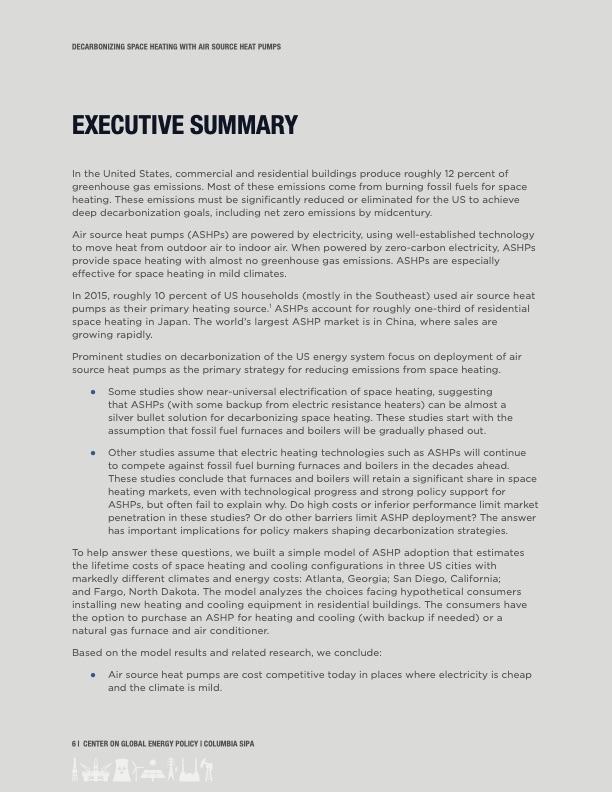
PDF Publication Title:
Text from PDF Page: 007
DECARBONIZING SPACE HEATING WITH AIR SOURCE HEAT PUMPS EXECUTIVE SUMMARY In the United States, commercial and residential buildings produce roughly 12 percent of greenhouse gas emissions. Most of these emissions come from burning fossil fuels for space heating. These emissions must be significantly reduced or eliminated for the US to achieve deep decarbonization goals, including net zero emissions by midcentury. Air source heat pumps (ASHPs) are powered by electricity, using well-established technology to move heat from outdoor air to indoor air. When powered by zero-carbon electricity, ASHPs provide space heating with almost no greenhouse gas emissions. ASHPs are especially effective for space heating in mild climates. In 2015, roughly 10 percent of US households (mostly in the Southeast) used air source heat pumps as their primary heating source.1 ASHPs account for roughly one-third of residential space heating in Japan. The world’s largest ASHP market is in China, where sales are growing rapidly. Prominent studies on decarbonization of the US energy system focus on deployment of air source heat pumps as the primary strategy for reducing emissions from space heating. ● Some studies show near-universal electrification of space heating, suggesting that ASHPs (with some backup from electric resistance heaters) can be almost a silver bullet solution for decarbonizing space heating. These studies start with the assumption that fossil fuel furnaces and boilers will be gradually phased out. ● Other studies assume that electric heating technologies such as ASHPs will continue to compete against fossil fuel burning furnaces and boilers in the decades ahead. These studies conclude that furnaces and boilers will retain a significant share in space heating markets, even with technological progress and strong policy support for ASHPs, but often fail to explain why. Do high costs or inferior performance limit market penetration in these studies? Or do other barriers limit ASHP deployment? The answer has important implications for policy makers shaping decarbonization strategies. To help answer these questions, we built a simple model of ASHP adoption that estimates the lifetime costs of space heating and cooling configurations in three US cities with markedly different climates and energy costs: Atlanta, Georgia; San Diego, California; and Fargo, North Dakota. The model analyzes the choices facing hypothetical consumers installing new heating and cooling equipment in residential buildings. The consumers have the option to purchase an ASHP for heating and cooling (with backup if needed) or a natural gas furnace and air conditioner. Based on the model results and related research, we conclude: ● Air source heat pumps are cost competitive today in places where electricity is cheap and the climate is mild. 6 | CENTER ON GLOBAL ENERGY POLICY | COLUMBIA SIPAPDF Image | DECARBONIZING SPACE HEATING WITH HEAT PUMPS

PDF Search Title:
DECARBONIZING SPACE HEATING WITH HEAT PUMPSOriginal File Name Searched:
HeatPump-CGEP_Report_010220.pdfDIY PDF Search: Google It | Yahoo | Bing
CO2 Organic Rankine Cycle Experimenter Platform The supercritical CO2 phase change system is both a heat pump and organic rankine cycle which can be used for those purposes and as a supercritical extractor for advanced subcritical and supercritical extraction technology. Uses include producing nanoparticles, precious metal CO2 extraction, lithium battery recycling, and other applications... More Info
Heat Pumps CO2 ORC Heat Pump System Platform More Info
| CONTACT TEL: 608-238-6001 Email: greg@infinityturbine.com | RSS | AMP |